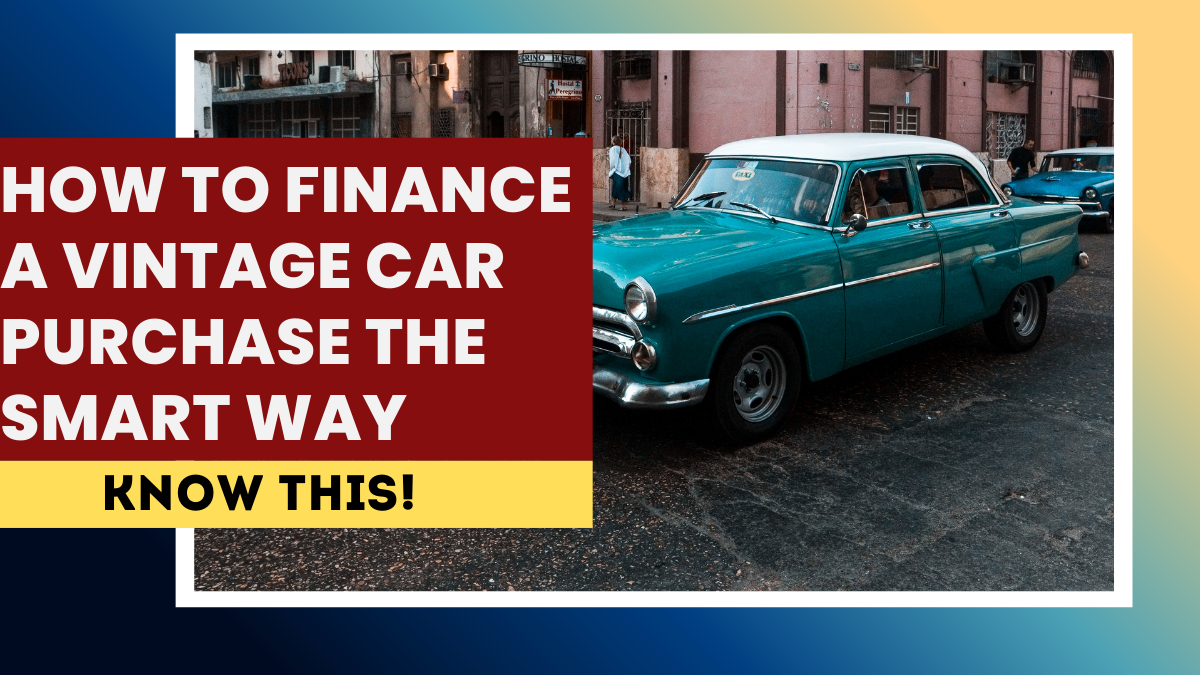Buying a vintage car is more than just a purchase—it’s fulfilling a dream. For many enthusiasts, owning a classic vehicle means preserving history, enjoying craftsmanship, and indulging in the thrill of nostalgic driving. However, these cars can come with hefty price tags, and not everyone has the means to pay upfront. That’s why learning how to finance a classic car purchase is crucial. With the right planning and smart strategies, you can enjoy vintage car ownership without stretching your finances beyond comfort.

Understanding the Cost of Vintage Cars
The first step before exploring vintage car financing options is understanding the overall cost of ownership. Beyond the purchase price, classic cars often require:
-
Restoration Expenses: Many need bodywork, repainting, or mechanical fixes.
-
Maintenance Costs: Older cars may need frequent servicing.
-
Insurance Premiums: Specialized policies for classics can be higher.
-
Storage Solutions: Safe storage in a garage or climate-controlled facility adds to costs.
Factoring these into your budget ensures you’re financially prepared for the long-term journey of vintage car ownership.
Financing Options for Classic Cars
Unlike modern vehicles, financing a vintage car often requires more specialized methods. Here are some of the best approaches:
Classic Car Loans
Some banks and credit unions offer loans tailored for collectible vehicles. These loans usually consider the car’s age, rarity, and appraised value rather than just its book price. They may have slightly higher interest rates compared to standard auto loans, but they’re specifically designed for vintage purchases.
Personal Loans
If your bank doesn’t provide classic car loans, a personal loan is another option. While not car-specific, it gives you flexibility to cover the purchase or restoration costs. The downside is higher interest rates, especially if credit scores are average.
Home Equity Loans or Lines of Credit
For buyers with home ownership, tapping into equity can provide larger loan amounts at lower interest rates. However, this puts your property at risk if repayments aren’t made on time. It’s a smart strategy only for those confident in their financial stability.
Peer-to-Peer Lending
Platforms that connect borrowers directly with lenders are becoming popular. Some cater specifically to enthusiasts looking for vintage car financing options, offering competitive rates for well-qualified applicants.
Auction House Financing
If you’re buying through major auction houses like RM Sotheby’s or Barrett-Jackson, many offer financing packages in partnership with banks. These loans are tailored for high-value classics and include appraisal services.
Tips for Financing Smartly
Financing a vintage car requires careful planning. Here are some auto loan tips to follow:
-
Set a Budget Before Bidding or Negotiating: Don’t get caught up in auction excitement.
-
Check Your Credit Score: Higher scores give you access to better interest rates.
-
Get Pre-Approved: Securing approval beforehand makes the buying process smoother.
-
Understand Loan Terms: Pay attention to repayment periods, fees, and insurance requirements.
-
Factor in Future Appreciation: Many classics rise in value, but don’t rely solely on appreciation to justify overspending.
Leasing as an Alternative
In rare cases, leasing options for vintage cars are available, particularly through luxury car leasing agencies. Leasing may be suitable for those who want temporary access to a rare car without long-term ownership costs. However, this option is limited and often applies to very high-value vehicles.
Protecting Your Investment
When financing a classic car, protecting it becomes a priority. Consider the following:
-
Comprehensive Insurance: Ensure your policy covers agreed value, not just market value.
-
Professional Appraisal: Lenders often require this, and it ensures fair coverage.
-
Secure Storage: Protects your investment from weather, theft, or vandalism.
-
Regular Maintenance: A well-maintained car holds value better, which is crucial for resale or refinancing.
Common Mistakes to Avoid
-
Ignoring Hidden Costs: Restoration and parts can cost more than expected.
-
Taking the Wrong Loan Type: Using standard auto loans can be tricky since many exclude older vehicles.
-
Overborrowing: Don’t finance more than you can comfortably repay.
-
Skipping Professional Help: Consulting financial advisors or car experts helps avoid costly errors.
Why Financing Classics Is Different
Unlike modern cars that depreciate quickly, many vintage cars hold or increase their value. This makes them unique from a financial standpoint. Financing one isn’t just about buying a car—it’s about securing a collectible asset. With proper planning, you’re not just spending money but investing in a piece of history.
Final Thoughts
Learning how to finance a classic car purchase the smart way allows enthusiasts to enjoy ownership without overwhelming their budget. From specialized loans and peer-to-peer lending to auction house financing, there are multiple paths available. The key is to research thoroughly, set realistic budgets, and protect your investment with the right insurance and storage. With thoughtful planning, you can make your dream of owning a vintage car a financial reality.
FAQs
Can I get a regular auto loan for a vintage car?
Not usually. Most banks limit auto loans to newer vehicles, so specialized loans or personal financing options are better.
Are vintage cars good investments?
Yes, many hold or increase in value, but returns vary by model, rarity, and condition.
What credit score is needed for a classic car loan?
A good credit score (typically 700+) helps secure better interest rates, though some lenders work with lower scores.
Should I finance or pay cash for a vintage car?
If you have the funds, cash avoids interest costs. However, financing spreads out payments and can free up cash for restoration or insurance.
Click here to know more.
